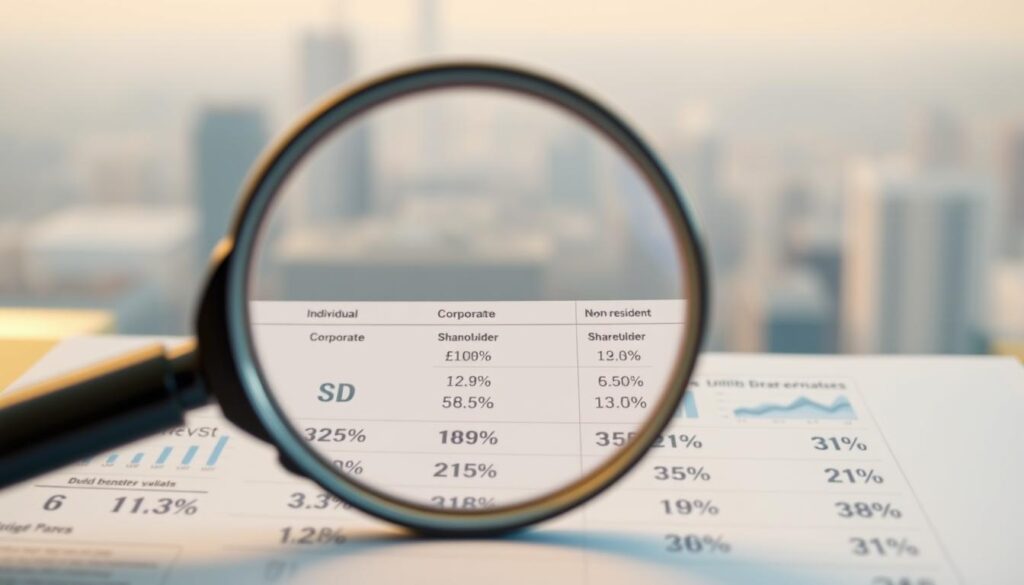We explain the core change that starts in YA 2025: a targeted 2% levy on annual dividend income above RM100,000 for individuals, while the single-tier system for companies remains intact.
Non-resident individuals face a 15% withholding charge on Malaysian payouts, often reduced by treaties. We also cover which streams stay exempt — such as foreign-sourced returns, pioneer status firms, EPF and certain trusts — and why that matters for your cash flow.
The IRBM requires enhanced dividend certificates from YA 2025 and self-assessment applies for resident recipients. We will show how to apportion chargeable amounts when you have multiple revenue sources and how to keep records that lower audit risk.
We guide you through practical examples and clear action steps so you can plan distributions, review structures, and align filings with the new rules.
Key Takeaways
- The 2% levy in YA 2025 applies only to amounts above RM100,000 for individuals.
- Single-tier framework for companies stays; resident payers have no company withholding.
- Non-residents face 15% withholding, subject to treaty relief where applicable.
- Certain streams remain exempt — review these for planning opportunities.
- Enhanced certificates and self-assessment are required; keep clear records.
Malaysia’s dividend landscape at present: from single-tier system to Budget 2025 updates
Since 2008, a single-tier system has simplified how corporate profits and shareholder payouts are treated. Companies pay corporate tax on profits once, and payouts to owners were no longer taxed again at the personal level.
How the single-tier system eliminated double taxation since 2008
The reform removed the need for franking accounts and cut administrative burdens for companies. Investors benefited because dividends distributed did not trigger further reporting at the shareholder level.
Why the government introduced a new dividend layer in 2025
Under Budget 2025, effective January 1, 2025, a 2% levy applies to individual dividend income above RM100,000 per year. The measure targets higher earners to broaden the tax base while keeping the corporate single-tier framework intact.
- Per taxpayer, per year: the threshold aggregates streams across payers.
- Companies: corporate tax on profits is unchanged; distributions remain largely exempt at shareholder level.
- Practical impact: high-distribution shareholders and family-owned firms should reassess payout planning.
We expect further IRB guidance on technical details and documentation, which will shape compliance and reporting next year.
Dividend Income Tax Malaysia: the new 2% levy explained
From YA 2025 a targeted 2% levy applies to the portion of an individual’s Malaysian-sourced dividend income that exceeds RM100,000 in a year.
How the threshold works: you total all local distributions received in the assessment year. Only the amount exceeding RM100,000 is chargeable at 2%.
Chargeable calculation: the levy applies to chargeable dividend income, not gross receipts. Where you get payouts from multiple payers, apportionment rules determine the taxable portion.
- Scope: resident and non-resident individuals are included, as are holdings via nominees. Corporate shareholders are excluded.
- Aggregation: amounts from multiple companies and payout dates in the same year are combined to test the threshold.
- Exemptions: specific streams remain outside the charge — correct classification is essential to avoid overpayment.
Why this measure exists: the levy targets high-net-worth individuals and family owners who favor distributions over remuneration. The IRBM will set computation rules to ensure consistent apportionment and reporting.
Residents vs non-residents: rates, withholding tax, and treaty relief
The new rules split treatment: residents handle a year-end charge, while non-residents generally face an at-source withholding. We set out practical differences and steps you should take to comply.
Resident individuals: year-end 2% on the excess
Residents must self-assess a 2% levy on the portion of annual Malaysian-sourced dividend income that exceeds RM100,000. Companies do not withhold this amount at source under the single-tier framework.
Report the charge in your annual return and keep clear records of payouts, certificates, and apportionment if you receive amounts from multiple payers.
Non-resident individuals: 15% withholding and treaty relief
Non-residents are subject to a 15% withholding tax on payouts by local companies. Where a double taxation agreement applies, the withholding rate may be reduced.
- To claim treaty relief you typically need a residency certificate and supporting documents from your tax authority.
- Timing matters: withholding occurs at payment, while treaty refunds or credits follow domestic procedures.
- Cross-border investors should assess how foreign credits and treaty benefits interact to avoid double taxation.
Practical note: expatriates and returning residents must monitor residency status within the year. A mid-year change can affect whether distributions are taxed at source or via self-assessment.
Dividend tax rates at a glance: individuals, companies, and non-resident shareholders
We provide a compact snapshot of the applicable rates so you can see how liabilities arise for different holders.

Individuals: base treatment up to RM100,000 and 2% on the excess
For resident individuals, the 2% rate applies only to the portion of annual Malaysian-sourced dividend income that exceeds RM100,000.
Base amounts up to RM100,000 remain effectively outside this new charge.
Companies: corporate tax rates and how dividends received are treated
Companies pay corporate tax on profits, generally at 24% with SME concessions for qualifying businesses.
Distributions continue under the single-tier system. That means dividends received by resident shareholders remain broadly exempt from further company-level levies.
Non-residents: flat withholding and potential treaty reductions
Non-resident individuals face a 15% withholding at source, subject to treaty relief where applicable.
We recommend checking residency documentation early to secure any lower rates available under double tax agreements.
What “chargeable dividend income” means in practice
Chargeable dividend income is the apportionable amount the IRBM uses when you get payouts from multiple payers.
The board’s formula links your share of distributions to overall taxable receipts. This affects mixed profiles — salary plus dividends, rental plus dividends, or dividend-only scenarios — and shows how the 2% interacts with your broader position.
- Personal: excess over RM100,000 taxed at 2%.
- Corporate: company profits bear corporate tax; shareholder exposure remains unchanged under single-tier rules.
- Non-resident: 15% withholding, subject to treaty reductions.
How to calculate the new dividend tax: formulas, examples, and edge cases
We set out the official apportionment and provide worked numbers so you can compute the chargeable portion with confidence.
Resident formula: Chargeable dividend income = (Dividend Statutory Income A / Aggregate Income B) × Chargeable Income C.
Use the parallel ratio for non-residents to isolate the assessable amount.
Worked examples
Resident example: A=150,000; B=300,000; C=250,000. The formula yields 125,000 as the chargeable dividend income. The amount exceeding 100,000 is 25,000. At a 2% rate the payment equals RM500.
Non-resident example: A=200,000; B=300,000; C=280,000. The computed chargeable amount is 186,667. The excess is 86,667 and 2% equals RM1,733. Note withholding rules apply at source for non-resident shareholders.
Timing, aggregation and edge cases
All distributions from multiple payers in the same year are aggregated. For dividend-only profiles the calculation simplifies: tax only the excess over the threshold directly.
- Watch mid-year residency changes and nominee holdings.
- Record vouchers and certificates to substantiate statutory figures.
- Account for scrip or in-kind payouts at market value and reconcile rounding.
Exemptions, exclusions, and special sources of dividends
Not all distributions trigger the new levy; several streams are explicitly exempt. We list key exemptions so you can separate reportable receipts from non-reportable ones.

Common exempt streams and why they matter
Exemptions include foreign-sourced payouts, proceeds from pioneer-status firms, and distributions tied to reinvestment allowances. Co‑operative society payouts, closed‑ended fund distributions, and shipping income with incentives are also excluded.
Statutory funds such as EPF, Armed Forces Fund Board and unit trusts (ASNB) typically provide exempt distributions. Resident receipts from Labuan entities are treated under special rules and often fall outside domestic charge.
| Stream | Typical payer | Notes |
|---|---|---|
| Foreign-sourced payouts | Overseas firms | Usually outside domestic levy unless remitted |
| Pioneer / incentive distributions | Incentivized entities | Require documentation of status |
| EPF / ASNB / unit trusts | Statutory funds | Statutory exemptions; common for retail investors |
| Labuan receipts | Labuan entities | Special regime; verify resident treatment |
Uncertainty: the IRB has not yet confirmed whether exempt streams count toward the RM100,000 threshold. We recommend separate tracking of exempt vs non‑exempt amounts to support any future position and to simplify your annual computation.
Compliance, reporting, and documentation investors should prepare now
Start preparing now: the new reporting rules change how shareholders must document and declare distributions each year.
Self-assessment and annual returns: Malaysia uses a self-assessment system. You must include the 2% charge for any dividend income exceeding RM100,000 in your annual return for YA 2025 and later.
Certificates companies must issue: payers should provide a certificate showing gross amounts, payer ID, payment dates and, for in‑kind distributions, the market value at distribution.
“Accurate vouchers and consistent identifiers reduce audit exposure and speed IRBM reconciliation.”
- Reconcile payouts from multiple companies, scrip issues and in‑kind items before filing.
- Keep exempt streams and non‑exempt streams in separate ledgers to test the RM100,000 threshold.
- Note: no resident withholding occurs at company level; settlement happens with your final payment.
| Action | Who | Why it matters |
|---|---|---|
| Issue enhanced certificate | Companies | Supports claimant records and IRBM matching |
| Reconcile vouchers | Shareholders | Prevents discrepancies at assessment |
| Segregate exempt receipts | Investors | Clarifies threshold calculation |
Practical note: update internal controls now and request corrections promptly where documentation is incomplete. Good compliance reduces risk and simplifies your annual assessment.
Conclusion
Conclusion
We view the change as a targeted measure with clear implications for higher‑distribution holders while the single‑tier framework for companies stays in place.
Assess your portfolio and family or entity structures to manage exposure. Track exempt sources separately and keep complete certificates and vouchers for your annual assessment.
For cross‑border positions, align treaty claims and documentation early to limit withholding leakage for non‑resident recipients.
Practical next steps: review distributions, engage advisors, and update reporting controls now so you can adopt the new rules smoothly and preserve accuracy while reducing audit risk.
FAQ
What changed with the 2025 measure and how does it interact with the single-tier system?
The 2025 measure introduced a 2% levy on distributions that exceed RM100,000 per year for individual residents, layered on top of the single-tier framework. The single-tier system still means companies do not suffer additional corporate-level charges when paying out profits, but affected shareholders may now face an extra assessment at the individual level once the annual threshold is exceeded.
Who is captured by the new 2% levy?
The rule targets resident individuals, but also affects nominees and high-net-worth persons when they receive distributions above the RM100,000 threshold in a tax year. Non-residents remain subject to withholding obligations under existing provisions, which are treated separately from the 2% resident measure.
How does the threshold mechanic work — is it per company or aggregated per person?
The RM100,000 threshold is aggregated at the recipient level for the assessment year. That means all payouts from different companies and funds count toward the same annual total when determining whether the 2% levy applies.
Are all forms of payouts treated the same when calculating chargeable amounts?
Not all payouts are identical. Ordinary distributions from locally taxed profits count toward the threshold, while certain exempt streams — such as pioneer incentives, approved cooperative distributions, some closed-ended fund payouts, and specific offshore or Labuan receipts — may be excluded. Guidance remains evolving on some categories, so keep documentation to support exclusions.
How do non-residents get taxed on distributions now?
Non-resident shareholders generally face a flat withholding rate (commonly 15%) on distributions, subject to reduction under applicable tax treaties. That treatment operates separately from the resident 2% levy and is withheld at source by the payer where required.
How should companies treat distributions for compliance and reporting?
Companies should continue to maintain clear distribution records and issue dividend or distribution certificates with required details. Those documents must show gross amounts, dates, payer identification, and any withholding applied so recipients can reconcile totals for their self-assessment and so the authority can verify compliance.
How do we calculate the 2% amount once the threshold is exceeded?
Compute the sum of assessable distributions received in the year. Subtract RM100,000; apply 2% to the excess. For mixed-source scenarios, treat each qualifying payout as part of the aggregate. Retain supporting schedules showing aggregation across payers and dates.
What are typical exemptions and how do they affect threshold calculations?
Exempt categories may include proceeds from pioneer-status activities, certain pension or EPF-related receipts, distributions from approved cooperatives and some closed-ended funds, and specific Labuan or foreign-source returns that remain outside domestic assessment. Whether an exempt receipt counts toward the RM100,000 cap depends on the statutory wording and IRB guidance; conservatively, you should treat clearly exempt receipts as excluded and document the basis.
How do treaty rules and double taxation relief interact with the new levy?
Treaty provisions primarily affect withholding for non-residents. The new resident levy is a domestic assessment on net distributions and is not ordinarily modified by treaties. However, where foreign tax credits or relief apply to cross-border payers, those factors can affect net chargeable amounts and should be reviewed in each case.
What documentation should recipients keep to meet compliance and reduce audit risk?
Keep distribution certificates, bank statements, corporate notices, share registers, and correspondence confirming exempt status. Maintain an annual schedule aggregating all payouts, withheld amounts, and calculations showing any 2% assessment. These records support accurate self-assessment and reduce the likelihood of adjustment.
Are companies’ corporate tax positions affected by this new levy?
Company-level profit taxation and corporate rates remain unchanged under the single-tier architecture. The new measure is assessed at the recipient level and does not alter the company’s corporate tax computation, although companies must ensure accurate withholding and reporting where they act as agents for non-resident obligations.
How will multiple payouts and different payers in the same year be treated for timing and aggregation?
All qualifying payouts within the same tax year are aggregated for that recipient. Timing matters only for the assessment year; multiple payers within that period contribute to the single RM100,000 threshold, so recipients should track cumulative totals throughout the year.
Where can we find official administrative guidance and updates?
Follow releases from the Inland Revenue Board of Malaysia and Budget 2025 documentation for formal rules, compliance timelines, and certificate templates. Engage tax advisors to interpret company-specific situations and any transitional measures published by authorities.

